Supersonic Mass, photo by Cat Dineley
On Sunday afternoon in Digbeth, an event dubbed the ‘Supersonic Mass’ is being held: a parade of banners and wonky effigies, led by a rag-tag band playing guitars, banjos, fiddles and unidentifiable found instruments, led by a robed figure whose white face is branded with the black chevrons that feature on much of the festival’s iconography. Arriving at 7SVN, one of the two main spaces at which this year’s Supersonic Festival is held, they stop in a messy semi-circle around the largest banner of all, which displays the name of every act who has performed in the event’s twenty year history. Each member of the parade shouts the names aloud, but each starting from a different point in the list so that the names tumble on top of each other. The musicians create a joyous din. Big names stick out above the racket – LCD Soundsystem, Broadcast, Sunn O))), Coil – as well as ‘wish-I-was-there’ one-off projects, and four different iterations of Oxbow (the regular band, plus choir, duo, and orchestra). Cacophonous, chaotic, communal, it’s the perfect way to celebrate two decades of Britain’s very best underground festival.
A few hours later in the same venue, Lankum’s Ian Lynch takes a moment between songs to shout out the organisers of Supersonic. Earlier, he tells us, he was stood in front of that banner, soaking in the fact that his own band’s name was now included on this illustrious list. Lankum might be riding high off the back of a universally lauded, Mercury-nominated masterpiece of a new album (tQ’s number one of the year so far, no less), yet the awe with which they speak about Supersonic is testament to the event’s oversized influence in the underground, a status earned over two decades hard graft. It’s not only the best festival they’ve ever played, Lynch, says, but the best they’ve ever been to.
It’s this writer’s first time at Supersonic after years of admiration from afar, yet the little touches that make Supersonic so loved are immediately apparent. Meals from the food court are affordable and generously portioned – to say nothing of the £1 samosas served behind each bar that live up to their cult status. The marketplace is given over to DIY stalls whose values clearly align with the rest of the festival’s. Face masks and earplugs are plentiful and free. The DJ sets at the roof garden upstairs – from which one can also peek into the unrelated reggae show in a yard next door on Sunday for bonus sensory overwhelm – are eclectic and strange. To quote Lynch one last time, “Even the security guards are sound.”
That being said, of course, the music’s still the main focus. Though the unavoidable last minute cancellations of MC Yallah and Matana Roberts (the former due to visa issues, the latter due to a positive COVID test) are the only blots on this year’s record, everything else is rarely short of remarkable. Tasked with picking out five highlights, the hardest part was narrowing things down. Here, then, in order of appearance, are eight of the best from Supersonic 2023.
Ex-Easter Island Head
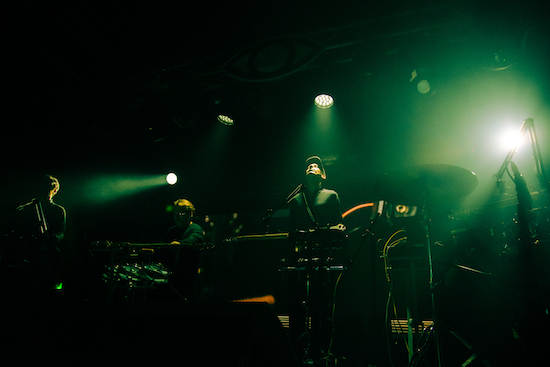
Ex-Easter Island Head, photo by Alice Needham
The opening act of Supersonic 2023, Ex-Easter Island Head’s music is so beautiful that at times it feels like the festival might have peaked within its first ten minutes. The Liverpool foursome are arranged in a line on the smaller Mill stage, the guitars lain flat which they’ve been playing since their inception joined by an array of cymbals, glockenspiels, synthesisers, bells and unidentifiable musical detritus. From it they produce music that shapeshifts across vastly different landscapes, sometimes akin to John Hassell’s Fourth World, chiming and beautiful, sometimes tender like a lost Studio Ghibli soundtrack, sometimes wild and unhinged. At one point it recalls Can’s ‘Millionenspiel’ performed only with church bells and a lawnmower.
The creation of this sound requires foursome to flurry between their different instruments and accessories – lowering what appear to be miniscule handheld motors to hover over the guitar strings, ringing tiny bells over their heads, playing cut up vocal samples through their phones and more. Each move is made with intent and deliberateness, but what’s interesting is how little they seem to look at one another. There are no furtive glances to cue up the next movement, no seams or sharp edges. And yet all their movements are made with intent and deliberateness; it doesn’t just feel improvisational. Everything grows organically, as if guided by something higher than the four musicians who stand onstage. Rarely do urgency and beauty come quite so tightly intertwined.
Ondata Rossa

Ondata Rossa, photo by Alice Needham
For the kind of person who attends Supersonic, the names involved with new project Ondata Rossa alone are exciting in and of themselves. Dali De Saint Paul of HARRGA, violinist Agathe Max, and Yoshino Shigihara (Yama Warashi) line up with Max centre stage, the other two angled towards her. Max acts as virtuoso soloist. The only one of the three who faces the audience, her playing is sturdy and intense, while her bandmates act like disruptors as they unleash cartwheels of harsh noise, distorted operatic vocals and punishing shapeless beats. From where we’re stood on the balcony we can hear the whirr of a vintage projector as Laura Phillips blends 16mm film footage and her own creations – cutting between old-time stripteases, what appear to be animal dissections, and footage of the band themselves, abstracted beautifully with rushes of vivid colour. Because of the way they’re stood facing one another – De Saint Paul all but has her back to us throughout – it’s as if their respective powers are being channelled entirely into the small triangle of empty stage floor in front of them, rather than the audience. As the show progresses, they pour more and more of their great bursts of sonic energy into this small point, and so it becomes more and more concentrated, stronger and stronger until it reaches critical, brilliant density.
Taqbir
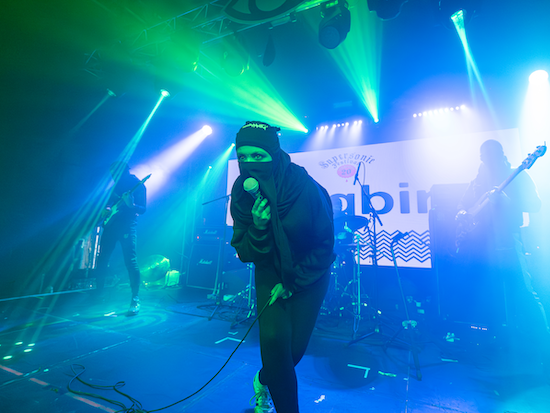
Taqbir, photo by John Convery
Taqbir’s message is clear. Moroccan-born, but now based at an undisclosed location in Europe, they use the primal force of hardcore punk to rail against those in the country who have historically acted to suppress those like them. The set lasts barely half an hour, the music brutal and sharp, yet it’s not short on depth. The relentless guitar chug that serves as their opening salvo, performed amid disorientating strobes of green light as the band arrive one by one as the band, builds a simmering momentum. Their vocalist, who like the rest of the band remains anonymous and hides her face for security reasons, is magnetic as she prowls from stage right to stage left. Each of their songs comes with an introduction. One is dedicated to queer people in Morocco, another serves as a warning to sexual harassers (“It’s they who should be scared”), another is an expression of gratitude to Supersonic for its platforming of non-white and non-male artists. All of it gives Taqbir’s set the edge that make this far, far more than your average hardcore rager.
Divide And Dissolve
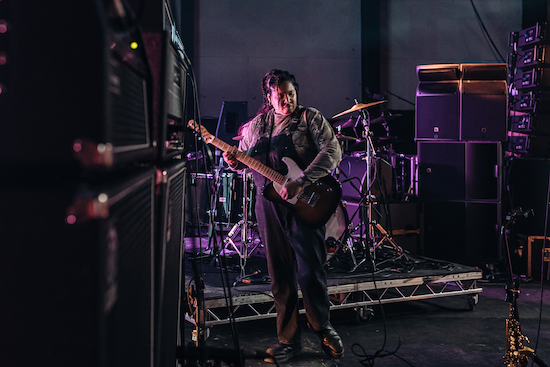
Divide And Dissolve, photo by snaprockandpop
Divide And Dissolve are loud. Loud enough to see even the most wizened of old school metalheads dash madly to the boxes of free earplugs set up on the bars, which are emptied like a cornfield being attacked a swarm of locusts. Loud enough to make your clothes vibrate against your skin. Loud enough that as guitarist Takiaya Reed’s crushing chords get bassier, you can feel the vibration plunging further down your throat. The band’s stated aim has always been to create music so loud that it can shake the foundations of white supremacy, and never has this description of the band’s politics felt so real. This set is so crushing that at times it feels as if the very ground beneath our feet might split in two.
Elvin Brandhi

Elvin Brandhi, photo by Alice Needham
For the first few minutes of Elvin Brandhi’s set it feels as if she’s finding the best way to (sonically) cave our heads in. Throwing out an anarchy of sounds, one after the other until eventually, some kind of psychic barrier begins to crack. Then it shatters. Suddenly this disparate barrage of noise all makes sense. The chaotic beats fall into new structures. Around it spins a galaxy of noise – part hyperpop glitz part machine gun dub, live vocals twisted beyond recognition. And yet for all the crazy complexity of Brandhi’s music, which is mostly improvised, her presence onstage makes for an intriguing contrast. Shrouded in darkness she is measured and deliberate, her equipment minimal. She unleashes a torrent of absolute power with the flick of the wrist, rewriting neural pathways as if it is the easiest thing in the world.
Shovel Dance Collective

Shovel Dance Collective’s ‘Ballad Of Digbeth’ workshop, photo by Ewan Williamson
Sunday’s programming contains a lot of folk and folk-influenced music, from headliners Lankum to this afternoon’s opening act Josephine Foster, but it’s Shovel Dance who most effectively channel this music’s sense of the communal; it’s apt that they take the stage immediately after the joy of the Supersonic Mass. The day before they performed one of the festival’s much-loved children’s shows (watering down their description of the baudy tale of a nautical threesome ‘The Handsome Cabin Boy’ for young ears, they assure us), and shortly before their full-scale set led a workshop in which audience members helped them pen ‘The Ballad Of Digbeth’. At the end of the set it’s sung as a chaotic and giddy group effort on the floor, onlookers craning and squinting at the giant scroll it’s been written on as they attempt to decipher the handwriting of its various authors. It’s no coincidence that leftist politics run through the group’s core; as vocalist Mataio Austin Dean reminds us onstage, folk has always been the music of the working class. This alone gives the band’s music an emboldening and inclusive quality; it’s clear from the enthusiastic comments tQ overhears among the crowd, and gushing texts spied nosily over shoulders, that they’re having an easy time converting newcomers. When coupled with the sheer beauty of much of the band’s playing – the hypnotic ebb and flow of ‘The Merry Golden Tree’ is particularly gorgeous – it makes for something profound.
BIG|BRAVE and Jessica Moss
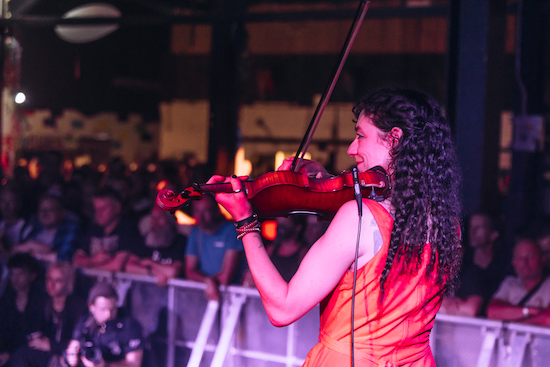
BIG|BRAVE and Jessica Moss, photo by snaprockandpop
The acoustics at 7SVN are phenomenal. For many, not least Divide And Dissolve, Saturday headliners Godflesh and local punks Total Luck whose Friday evening show is also searingly loud, this can easily be exploited when requiring overwhelming volume. Yet the collaborative show between experimental metal trio BIG|BRAVE and their fellow Montrealer, violinist Jessica Moss, and which they spoke to tQ about in depth ahead of the festival, is the one that makes most complete use of the space. They bestow not just noise, but beauty too. The music they make is so big that it feels as if it reaches every nook and cranny of the reclaimed warehouse, blanketing everything it finds. The set consists of two pieces, long and sprawling. The first is the more hypnotic, beginning with ornate solo violin from Moss, setting an air of grandness that BIG|BRAVE’s great droning waves then take on themselves. Formidable vocals cut through the fog like a beam of light through dark. The second sees the sound start to fragment with terrifying beauty, the sonic equivalent of watching melting glaciers crack and plunge into the ocean.
Lankum
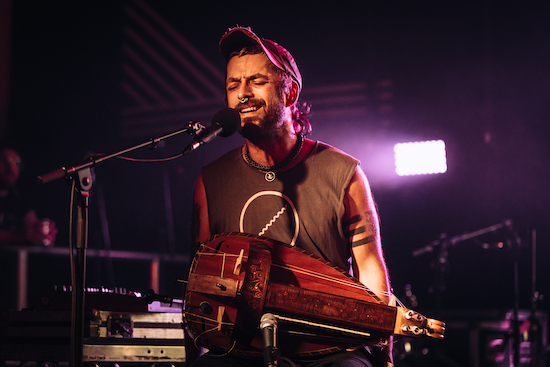
Lankum, photo by snaprockandpop
Lankum have the air of a band at their peak. Theirs is probably the most anticipated set of all at this year’s Supersonic, with an air of jittery expectation hanging over a full-to-bursting crowd. Rising to the occasion and then exceeding this expectation, their set is an all-timer. As their version of ‘The Wild Rover’ progresses, something almost feral begins to take hold of the crowd, each layer of texture (and Lankum add one hell of a lot of layers) greeted with yowls and howls of increasing volume. When ‘The New York Trader’, which follows, reaches its tempestuous second half – the energy boils over into all-out rapture. When tQ interviewed the band earlier this year about their phenomenal new record False Lankum, vocalist Radie Peat told us about how as the band’s career progresses, their emotional extremes grow more and more pronounced. Live, they’re pushed out even further. Just as the band’s stormier moments reach the levels of a category five hurricane, their moments of tenderness grow more beautiful to redress the balance. Tonight’s rendition of ‘The Young People’, dedicated to all those who’ve "brought a ghost along with them" into the building, is enough to bring this writer to tears.


